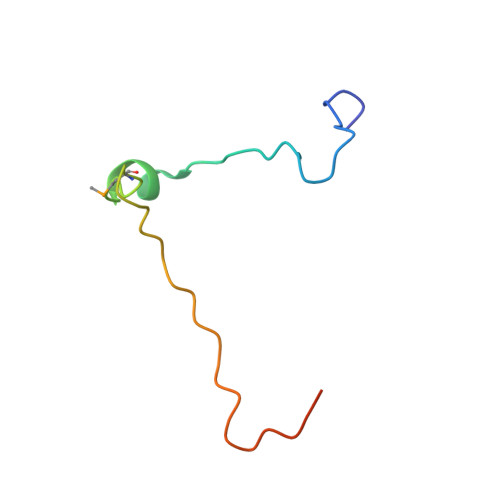BRCA2 binding through a cryptic repeated motif to HSF2BP oligomers does not impact meiotic recombination.
Ghouil, R., Miron, S., Koornneef, L., Veerman, J., Paul, M.W., Le Du, M.H., Sleddens-Linkels, E., van Rossum-Fikkert, S.E., van Loon, Y., Felipe-Medina, N., Pendas, A.M., Maas, A., Essers, J., Legrand, P., Baarends, W.M., Kanaar, R., Zinn-Justin, S., Zelensky, A.N.(2021) Nat Commun 12: 4605-4605
- PubMed: 34326328
- DOI: https://doi.org/10.1038/s41467-021-24871-6
- Primary Citation of Related Structures:
7BDX - PubMed Abstract:
BRCA2 and its interactors are required for meiotic homologous recombination (HR) and fertility. Loss of HSF2BP, a BRCA2 interactor, disrupts HR during spermatogenesis. We test the model postulating that HSF2BP localizes BRCA2 to meiotic HR sites, by solving the crystal structure of the BRCA2 fragment in complex with dimeric armadillo domain (ARM) of HSF2BP and disrupting this interaction in a mouse model. This reveals a repeated 23 amino acid motif in BRCA2, each binding the same conserved surface of one ARM domain. In the complex, two BRCA2 fragments hold together two ARM dimers, through a large interface responsible for the nanomolar affinity - the strongest interaction involving BRCA2 measured so far. Deleting exon 12, encoding the first repeat, from mBrca2 disrupts BRCA2 binding to HSF2BP, but does not phenocopy HSF2BP loss. Thus, results herein suggest that the high-affinity oligomerization-inducing BRCA2-HSF2BP interaction is not required for RAD51 and DMC1 recombinase localization in meiotic HR.
Organizational Affiliation:
Institute for Integrative Biology of the Cell (I2BC), CEA, CNRS, Uni Paris-Sud, Uni Paris-Saclay, Gif-sur-Yvette, France.

















